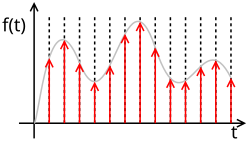Sample and hold

Okay kiddo, have you ever played with a squirt gun or water bottle and noticed how the water comes out in a stream? But if you stop squeezing the trigger or opening the cap, the water stops flowing and stays in the same spot, right?
Now imagine that water is sound waves, which are vibrations that our ears can hear. When we want to record or process those sound waves in electronics, we need to make sure we capture them at a certain moment in time so we can work with them later. That's where the Sample and Hold (S&H) circuit comes in!
Think of the S&H circuit as a little bucket that sits in front of the stream of sound waves, waiting for a command from the grown-ups to take a snapshot of the water level. When it gets that signal, it quickly scoops up some of the water and holds it still, like a photo, until it gets another signal to let it go and catch the next stream.
This way, we can freeze one "frame" of sound waves and use it as a reference for our electronics to analyze or modify it. We can do this many times per second or even per millisecond, creating a series of frozen frames that we can put together like a flip-book animation to create a smooth playback of audio or other signals.
So next time you see a squirt gun or water bottle, remember that it's a little bit like a Sample and Hold circuit for water, except it's much faster and works with sound waves instead!
Now imagine that water is sound waves, which are vibrations that our ears can hear. When we want to record or process those sound waves in electronics, we need to make sure we capture them at a certain moment in time so we can work with them later. That's where the Sample and Hold (S&H) circuit comes in!
Think of the S&H circuit as a little bucket that sits in front of the stream of sound waves, waiting for a command from the grown-ups to take a snapshot of the water level. When it gets that signal, it quickly scoops up some of the water and holds it still, like a photo, until it gets another signal to let it go and catch the next stream.
This way, we can freeze one "frame" of sound waves and use it as a reference for our electronics to analyze or modify it. We can do this many times per second or even per millisecond, creating a series of frozen frames that we can put together like a flip-book animation to create a smooth playback of audio or other signals.
So next time you see a squirt gun or water bottle, remember that it's a little bit like a Sample and Hold circuit for water, except it's much faster and works with sound waves instead!
Related topics others have asked about:
